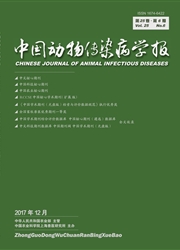

 中文摘要:
中文摘要:
为了解上海市动物源性食品中单增李斯特菌的污染状况,在上海市不同超市和农贸市场采集479份动物源性食品样品,依据国标方法进行菌株分离,并对分离菌株的耐药性、血清型及生物被膜形成能力进行测定。结果共分离鉴定34株单增李斯特菌,分离率为7.1%(34/479)。药敏试验结果显示单增李斯特菌分离株的耐药率虽然不高,但日趋严重,对氨苄青霉素和万古霉素均敏感,对头孢曲松的耐药性最高(55.88%),林可霉素次之(41.18%)。血清型鉴定表明单增李斯特菌分离株以血清型1/2a(3a)型为主(76.47%),血清型1/2c(3c)次之(17.65%),而致病性强的血清型4b(4d、4e)仅占2.94%。生物被膜形成能力实验表明,所有的菌株均能形成生物被膜,其中76.47%(26/34)分离株生物被膜形成能力微弱。上海市动物源性食品中单增李斯特菌污染情况较为严重,主要流行1/2a(3a)血清型,耐药率日趋严重,均可形成生物被膜。因此,应加强对动物源性食品中单增李斯特菌的监控。
 英文摘要:
英文摘要:
This study was performed to investigate the contamination of Listeria monocytogenes(LM) in animal origin food in Shanghai, which gained further insights on the public health risk caused by this food borne pathogen. A total of 479 animal origin food samples were screened for LM. Then, the antibiotic sensitivity, serotype and biofilm formation of each isolate were determined. The results showed that 34 LM strains were isolated from 479 samples, which accounted for 7.1%. The antibiotics resistance tests showed that resistant rate of LM isolates were not high. All LM isolates were sensitive to ampicillin and vancomycin. However, 55.88% isolates were resistant rate to ceftriaxone, followed by lincomycin(41.18%). Serotying results showed that 76.47% LM strains were belonged to serovar 1/2a(3a), followed by serovar 1/2c(3c). Whereas, only one isolate(2.94%) was the pathogenic serotype 4b(4d、4e). Bioilm formation assays showed that all the LM isolates could produce biofilm, in which 76.47%(26/34)were weak biofilm producers. These results indicated that animal origin food was contatiminated by LM, and the biofilm will increase the chances of LM contamination. Thus, it is necessary to inspect and survey the contamination by LM on farms and in abattoirs to reduce the incidence of foodborne infections in humans.
 同期刊论文项目
同期刊论文项目
 同项目期刊论文
同项目期刊论文
 Molecular characterization of enterohemorrhagic E. coli O157 isolated from animal fecal and food sam
Molecular characterization of enterohemorrhagic E. coli O157 isolated from animal fecal and food sam 期刊信息
期刊信息
